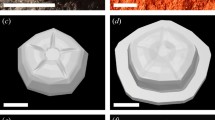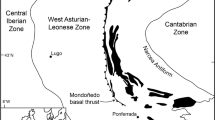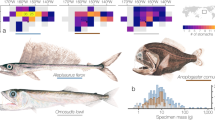Abstract
Large, actively swimming suspension feeders evolved several times in Earth’s history, arising independently from groups as diverse as sharks, rays and stem teleost fishes1, and in mysticete whales2. However, animals occupying this niche have not been identified from the early Palaeozoic era. Anomalocarids, a group of stem arthropods that were the largest nektonic animals of the Cambrian and Ordovician periods, are generally thought to have been apex predators3,4,5. Here we describe new material from Tamisiocaris borealis6, an anomalocarid from the Early Cambrian (Series 2) Sirius Passet Fauna of North Greenland, and propose that its frontal appendage is specialized for suspension feeding. The appendage bears long, slender and equally spaced ventral spines furnished with dense rows of long and fine auxiliary spines. This suggests that T. borealis was a microphagous suspension feeder, using its appendages for sweep-net capture of food items down to 0.5 mm, within the size range of mesozooplankton such as copepods. Our observations demonstrate that large, nektonic suspension feeders first evolved during the Cambrian explosion, as part of an adaptive radiation of anomalocarids. The presence of nektonic suspension feeders in the Early Cambrian, together with evidence for a diverse pelagic community containing phytoplankton7,8 and mesozooplankton7,9,10, indicate the existence of a complex pelagic ecosystem11 supported by high primary productivity and nutrient flux12,13. Cambrian pelagic ecosystems seem to have been more modern than previously believed.
This is a preview of subscription content, access via your institution
Access options
Subscribe to this journal
Receive 51 print issues and online access
$199.00 per year
only $3.90 per issue
Buy this article
- Purchase on SpringerLink
- Instant access to full article PDF
Prices may be subject to local taxes which are calculated during checkout




Similar content being viewed by others
References
Friedman, M. et al. 100-Million-year dynasty of giant planktivorous bony fishes in the Mesozoic seas. Science 327, 990–993 (2010)
Marx, F. G. & Uhen, M. D. Climate, critters, and cetaceans: Cenozoic drivers of the evolution of modern whales. Science 327, 993–996 (2010)
Whittington, H. B. & Briggs, D. E. G. The largest Cambrian animal, Anomalocaris, Burgess Shale, British Columbia. Phil. Trans. R. Soc. B 309, 569–609 (1985)
Paterson, J. R. et al. Acute vision in the giant Cambrian predator Anomalocaris and the origin of compound eyes. Nature 480, 237–240 (2011)
Daley, A. C., Paterson, J. R., Edgecombe, G. D., García-Bellido, D. C. & Jago, J. B. New anatomical information on Anomalocaris from the Cambrian Emu Bay Shale of South Australia and a reassessment of its inferred predatory habits. Palaeontology 56, 971–990 (2013)
Daley, A. C. & Peel, J. S. A possible anomalocaridid from the Cambrian Sirius Passet Lagerstatte, North Greenland. J. Paleont. 84, 352–355 (2010)
Butterfield, N. J. Plankton ecology and the Proterozoic-Phanerozoic transition. Paleobiology 23, 247–262 (1997)
Vidal, G. & Knoll, A. H. Radiations and extinctions of plankton in the late Proterozoic and early Cambrian. Nature 297, 57–60 (1982)
Harvey, T. H. P. & Butterfield, N. J. Sophisticated particle-feeding in a large Early Cambrian crustacean. Nature 452, 868–871 (2008)
Harvey, T. H. P., Vélez, M. I. & Butterfield, N. J. Exceptionally preserved crustaceans from western Canada reveal a cryptic Cambrian radiation. Proc. Natl Acad. Sci. USA 109, 1589–1594 (2012)
Vannier, J., Steiner, M., Renvoisé, E., Hu, S.-X. & Casanova, J.-P. Early Cambrian origin of modern food webs: evidence from predator arrow worms. Proc. R. Soc. Lond. B 274, 627–633 (2007)
Brasier, M. Nutrient flux and the evolutionary explosion across the Precambrian-Cambrian boundary interval. Hist. Biol. 5, 85–93 (1991)
Peters, S. E. & Gaines, R. R. Formation of the ‘Great Unconformity’ as a trigger for the Cambrian explosion. Nature 484, 363–366 (2012)
Briggs, D. E. G. Anomalocaris, the largest known Cambrian arthropod. Palaeontology 22, 631–664 (1979)
Daley, A. C. & Budd, G. E. New anomalocaridid appendages from the Burgess Shale, Canada. Palaeontology 53, 721–738 (2010)
Jørgensen, C. B. Biology of Suspension Feeding (Pergamon, 1966)
Pivorunas, A. The feeding mechanisms of baleen whales. Am. Sci. 67, 432–440 (1979)
Nemoto, T. in Marine Food Chains (ed. Steele, J. H. ) 241–252 (Univ. California Press, 1970)
Daley, A. C. & Bergström, J. The oral cone of Anomalocaris is not a classic “peytoia”. Naturwissenschaften 99, 501–504 (2012)
Hou, X.-G., Bergström, J. & Ahlberg, P. Anomalocaris and other large animals in the lower Cambrian Chengjiang fauna of southwest China. GFF 117, 163–183 (1995)
Friedman, M. Parallel evolutionary trajectories underlie the origin of giant suspension-feeding whales and bony fishes. Proc. R. Soc. B 279, 944–951 (2012)
Kruta, I., Landman, N., Rouget, I., Cecca, F. & Tafforeau, P. The role of ammonites in the Mesozoic marine food web revealed by jaw preservation. Science 331, 70–72 (2011)
Signor, P. W. & Vermeij, G. J. The plankton and the benthos: origins and early history of an evolving relationship. Paleobiology 20, 297–319 (1994)
Tynan, C. T. Ecological importance of the Southern Boundary of the Antarctic Circumpolar Current. Nature 392, 708–710 (1998)
Cook, P. J. & Shergold, J. H. Phosphorus, phosphorites and skeletal evolution at the Precambrian–Cambrian boundary. Nature 308, 231–236 (1984)
Vinther, J., Smith, M. P. & Harper, D. A. T. Vetulicolians from the Lower Cambrian Sirius Passet Lagerstätte, North Greenland, and the polarity of morphological characters in basal deuterostomes. Palaentology 54, 711–719 (2011)
Stein, M., Peel, J. S., Siveter, D. J. & Williams, M. Isoxys (Arthropoda) with preserved soft anatomy from the Sirius Passet Lagerstatte, lower Cambrian of North Greenland. Lethaia 43, 258–265 (2010)
Vannier, J., García-Bellido, D. C., Hu, S.-X. & Chen, A.-L. Arthropod visual predators in the early pelagic ecosystem: evidence from the Burgess Shale and Chengjiang biotas. Proc. R. Soc. B 276, 2567–2574 (2009)
Dunne, J. A., Williams, R. J., Martinez, N. D., Wood, R. A. & Erwin, D. H. Compilation and network analyses of Cambrian food webs. PLoS Biol. 6, e102 (2008)
Gould, S. J. Wonderful Life: The Burgess Shale and the Nature of History (W. W. Norton & Co., 1989)
Ineson, J. R. & Peel, J. S. Geological and depositional setting of the Sirius Passet Lagerstätte (Early Cambrian), North Greenland. Can. J. Earth Sci. 48, 1259–1281 (2011)
Peel, J. S. & Ineson, J. R. The extent of the Sirius Passet Lagerstätte (early Cambrian) of North Greenland. Bull Geosci 86, 535–543 (2011)
Geller, W. & Müller, H. The filtration apparatus of Cladocera: filter mesh-sizes and their implications on food selectivity. Oecologia 49, 316–321 (1981)
Jerling, H. & Wooldridge, T. Feeding of two mysid species on plankton in a temperate South African estuary. J. Exp. Mar. Biol. Ecol. 188, 243–259 (1995)
Boyd, C. M., Heyraud, M. & Boyd, C. N. The biology of the Antarctic krill Euphausia superba. J. Crust. Biol. 4, 123–141 (1984)
Tanaka, H., Aoki, I. & Ohshimo, S. Feeding habits and gill raker morphology of three planktivorous pelagic fish species off the coast of northern and western Kyushu in summer. J. Fish Biol. 68, 1041–1061 (2006)
Budy, P., Haddix, T. & Schneidervin, R. Zooplankton size selection relative to gill raker spacing in rainbow trout. Trans. Am. Fisheries Soc. 134, 1228–1235 (2005)
Jenkin, P. M. The filter-feeding and food of flamingoes (Phoenicopteri). Phil. Trans. R. Soc. Lond. B 240, 401–493 (1957)
Motta, P. J. et al. Feeding anatomy, filter-feeding rate, and diet of whale sharks Rhincodon typus during surface ram filter feeding off the Yucatan Peninsula, Mexico. Zoology 113, 199–212 (2010)
Werth, A. J. Flow-dependent porosity and other biomechanical properties of mysticete baleen. J. Exp. Biol. 216, 1152–1159 (2013)
Barkley, E. Nahrung und Filterapparat des Walkrebschens Euphausia superba Dana. Z. Fisch. 1, 65–156 (1940)
Chen, Y.-Y. et al. Description of a new species of coral-inhabiting barnacle, Darwiniella angularis sp. n. (Cirripedia, Pyrgomatidae) from Taiwan. ZooKeys 214, 43–74 (2012)
Acknowledgements
Our expeditions to North Greenland were financed by Geocenter Denmark, the Agouron Institute and the Carlsberg Foundation. We are grateful for discussions with members of the Bristol Palaeobiology group, E. Sperling, C. Hull, M. Matz and M. Friedman. M.S. was supported by the Carlsberg Foundation. We thank POLOG for logistic support. A. T. Nielsen and M. P. Smith assisted in the field in 2009. S. Powell assisted with figures. S. L. Jakobsen and A. T. Nielsen facilitated work and curation of the collected material at the Statens Naturhistoriske Museum, Copenhagen.
Author information
Authors and Affiliations
Contributions
J.V., M.S. and N.R.L. designed, analysed and performed research. D.A.T.H. obtained funding for the fieldwork. J.V., M.S., N.R.L. and D.A.T.H. wrote and discussed the paper.
Corresponding author
Ethics declarations
Competing interests
The authors declare no competing financial interests.
Extended data figures and tables
Extended Data Figure 1 T. borealis MGUH 30500, frontal appendage.
a, Part, photographed in low-angle lighting coated with MgO. b, Camera lucida drawing with spines indicated (s1–s15). Bs, spines broken at the base. c, Detail of spine preserving auxiliary spines in relief (arrowed).
Extended Data Figure 2 T. borealis MGUH 30500, frontal appendage.
a, Part, photographed submerged in water and with high-angle illumination. b, Counterpart, displaying articulating membranes across the appendage, as indicated by their relatively lower reflectivity. c, Detail of b, and the articulating membranes (Am) and articles (Art) along the mid-section of the appendage. d, Detail of broken spine in b, displaying auxiliary spines.
Extended Data Figure 3 T. borealis MGUH 30501 frontal appendage with well-preserved auxiliary spines.
a, Part. b, Detail of auxiliary spines in a. c, Schematic drawing of MGUH 30501, from a combination of part and counterpart. d, Counterpart. e, Detail of d showing regular arrangement of auxiliary spines.
Extended Data Figure 4 MGUH 30502 frontal appendages and head shield assemblage, lateral view.
a, Part. b, Camera lucida drawing of the part indicating the head shield (Hs), left frontal appendage (Lfa) and right frontal appendage (Rfa). Partially superimposed on the specimen is the arthropod Buenaspis (Ba). c, Detail of distal section of frontal appendages in counterpart. d, Detail of head shield.
Extended Data Figure 5 Modern crustacean suspension feeders.
a, The Northern krill, Meganyctiphanes norvegica (image reproduced with permission from Wikipedia/Ø. Paulsen). Insert shows a reconstruction of the thoracic region of the krill, Euphausia suberba, reproduced from ref. 41 with permission of Verlag J. Neuman-Neudamm. b, Proximal elements of the thoracopods in E. suberba (image reproduced with permission from U. Kils). c, Distal elements of the thoracopods in E. suberba (image reproduced with permission from U. Kils). d, The filter basket in an undetermined mysid (image reproduced with permission from Wikipedia/U. Kils). e, Thoracopod from the cirripede Darwiniella angularis (image reproduced with permission from ref. 42).
Extended Data Figure 6 Schematic drawings of different anomalocarid frontal appendages.
a, T. borealis. b, A. briggsi. c, A. canadensis. d, A. cf. saron, NIGP 154565. e, Amplectobelua symbrachiata. f, A. stephenensis. g, Hurdia victoria. h, Stanleycaris hirpex.
Extended Data Figure 7 A schematic overview of some of the known components the Early Cambrian pelagic food web.
At the base of the food chain were phytoplankton in the form of acritarchs and probably other forms with no apparent fossil record. Diverse mesozooplankton were present as copepod and branchiopod-like crustaceans feeding on phytoplankton, along with vetulicolians, which exhibit a morphology suggesting suspension feeding similar to basal chordates. Larger pelagic predators such as chaetognaths, larger arthropods and potentially also ctenophores preyed upon the mesozooplankton. Tamisiocaris would similarly have fed on the mesozooplankton. The presence of a large nektonic suspension feeder suggests a high abundance of primary producers and mesozooplankton. Other anomalocarids, such as Anomalocaris and Amplectobelua were present as some of the macrophagous apex predators at this time.
Supplementary information
Supplementary Information
Taxonomy and Systematics: This file contains information on the cladistics analysis, the characters and taxa used, as well as our suggested revised higher taxonomy. (PDF 573 kb)
Supplementary Information
This Nexus file contains the character codings by taxon used in the cladistics analyses. (TXT 14 kb)
An animation of the frontal appendages of Tamisiocaris borealis based on the single articulated assemblage and in relation to a radiodont mouth apparatus.
This video shows the ventral view and serves to illustrate schematically the range of motions inferred by T. borealis. (MOV 10846 kb)
An animation of the frontal appendages of Tamisiocaris borealis based on the single articulated assemblage and in relation to a radiodont mouth apparatus.
This video shows the lateral view and serves to illustrate schematically the range of motions inferred performed by T. borealis. (MOV 14305 kb)
Rights and permissions
About this article
Cite this article
Vinther, J., Stein, M., Longrich, N. et al. A suspension-feeding anomalocarid from the Early Cambrian. Nature 507, 496–499 (2014). https://doi.org/10.1038/nature13010
Received:
Accepted:
Published:
Issue Date:
DOI: https://doi.org/10.1038/nature13010
This article is cited by
-
Ordovician opabiniid-like animals and the role of the proboscis in euarthropod head evolution
Nature Communications (2022)
-
Houcaris gen. nov. from the early Cambrian (Stage 3) Chengjiang Lagerstätte expanded the palaeogeographical distribution of tamisiocaridids (Panarthropoda: Radiodonta)
PalZ (2021)
-
First report of paired ventral endites in a hurdiid radiodont
Zoological Letters (2019)
-
Brain and eyes of Kerygmachela reveal protocerebral ancestry of the panarthropod head
Nature Communications (2018)
-
New suspension-feeding radiodont suggests evolution of microplanktivory in Cambrian macronekton
Nature Communications (2018)




